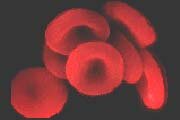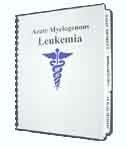 |
||
| HOME | ||
 |
||
| Acute Myelogenous Leukemia (AML) |
||
 |
||
| Other Leukemia Types (ALL / CLL / CML / HCL) |
||
 |
||
| Myelodysplastic Syndrome | ||
 |
||
| Symptoms and Diagnosis | ||
 |
||
| Leukemia Treatment Options | ||
 |
||
| " Chemotherapy | ||
 |
||
| " Blood Stem Cell Transplants | ||
 |
||
| " Radiation and Surgery | ||
 |
||
| " Chemo Side Effects | ||
 |
||
| " Clinical Trials Info | ||
 |
||
| " Coping with Leukemia | ||
 |
||
| " What to Ask Your Doctor | ||
 |
||
| Financial Assistance | ||
 |
||
| At Risk Jobs/Exposure | ||
 |
||
| Leukemia Resources | ||
 |
||
| Survivor's Story | ||
 |
||
| Leukemia News | ||
 |
||
|
Search for information:
|
||

|
Leukemia Cancer News - Return to Menu The Unconquered Twin ERIC FRAZIER Dec. 18, 2005 - As toddlers, Brett and Cameron Hudson soaked up sights through identical pairs of expressive, green-gold eyes. But 20 years later, as they graduated Saturday from UNC Charlotte, they weren't identical anymore. Cameron stands 6 foot 1 with thick, dark brown hair, a lean, athletic torso and an angular face. Brett is a foot shorter, with a rounder face, wire-rimmed glasses and thinning hair. Though they remain genetic duplicates, the visual contrast stings for Brett -- particularly when girls come around. It's not easy looking at your brother and seeing the man you were supposed to be. Sometimes, people are surprised to learn the two are brothers. When they say they're identical twins, people do a double take. "Then," Brett says, "we have to tell the story." A fight for life They took Brett to the doctor the next day, figuring it was no big deal. It turned out to be acute myelogenous leukemia, a cancer in which the bone marrow makes too many white blood cells. It usually strikes adults, not children. Brett's chance for surviving was 1 in 5. He needed a bone marrow transplant. Luckily, Cameron could supply a perfect match. Brett went through chemotherapy at Presbyterian. The family also traveled to Minneapolis, where doctors bombarded his 2-year-old body with massive doses of radiation. It took out his hair, his eyelashes, his eyebrows. It left him pale and thin. "Hurt," he told his mom. "Hurt." With his immune system weakened, Brett had to stay for months in the hospital, where doctors put him in a special plastic-covered crib to protect him from germs. For the first time, he and Cameron were separated. When his brother visited, Brett usually perked up. They babbled in their "twin language" no one else could understand. The doctors performed the transplant in June 1986, injecting Cameron's bone marrow into Brett's bloodstream. Then, they waited. A miracle and a mystery The bone marrow transplant from Cameron, a dozen years earlier, had saved Brett's life. He could do just about anything Cameron could do, though he often had to work harder. The radiation had stunted his growth, leaving him about 5 inches shorter than his twin. He was legally blind in his right eye. He had metal pins in both hips to support radiation-damaged bones. They looked like brothers, still, but not identical twins. Doctors had said that once Brett lived five years without relapsing, the family could consider him cured. Every year they took him for checkups. Every year the doctors said he was fine. So when Brett's nose bled during his chess match, his father thought little of it, even though he knew unexplained bleeding could be a bad sign. At Brett's annual checkup a few days later, the doctor pulled Maria aside: The leukemia was back. The family turned this time to Duke University Medical Center in Durham. Dr. Paul Martin, an associate professor of pediatrics, had never heard of a relapse this far beyond the five-year benchmark. Brett's chances weren't good. Less than 5 percent, Martin figured. The hospital chaplain took Maria's hands in his and said he was sorry. But Monday came, and Brett still held on. Tuesday came, and they wheeled Brett down from the intensive care unit into his regular room. Two of a kind Brett looks at Cameron. Cameron looks at Brett. It's a twin thing -- no different from the made-up language they shared as toddlers. Their dad has seen Cameron and Brett cut up like this for years, and always feels as if he has missed the joke. It's easy to laugh now. Brett's been cancer-free since the last transplant. But whenever they break out family scrapbooks, the smiles vanish. Cameron wonders why he didn't get sick. Doctors gave him about a 25 percent chance of developing leukemia, but he never did. Why Brett? "Is there something special about me?" Cameron asks. "Or is there something special about him?" The boys' parents and their minister call Brett's survival a miracle. Dr. Martin calls it a mystery, a case that doesn't play by medical rules. Going separate ways Getting started is proving harder for Brett than Cameron. That's the way it's always been. That's the way Dr. Martin said it would be. But Brett remembers something else the doctor told him after the second transplant: Your life will be harder, but it will be more meaningful, too. Brett didn't understand back then. He thought, Yeah, right. You'll be driving off in your BMW after this. What do you know? But now it makes sense. He realizes every day is a gift. No one's guaranteed to make it to 80, or 40, or even to tomorrow. He has parents who've done more for him than he can ever repay. He has a brother he can tell anything to. And he just graduated from college. Brett Hudson is becoming the man he was destined to be. And he's convinced he'll never again need to plan his future in five-year segments. Come 2010, there's only one thing he's concerned about having. |
|
|


